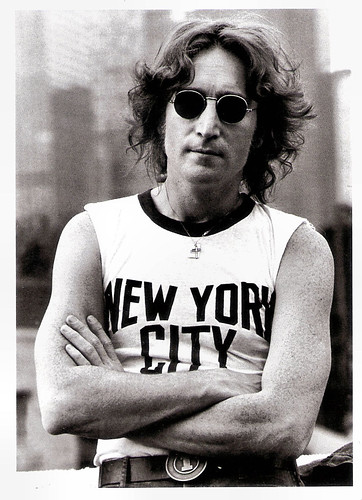
British postcard by Photofolio. Photo: Bob Gruen. Caption: New York City, 1974.

Italian postcard by Gruppo Editoriale Lo Vecchio, Genova. The Beatles.

British postcard by London Postcard Company, no YS 5314 (Series 2 set of 9). Photo: Subafilms Ltd. Film image of The Yellow Submarine (George Dunning, 1968). Caption: Up on the hill.

Italian postcard by Gruppo Editoriale Lo Vecchio, Genova. Photo: G.E.L. / Silvestre Suoni.

Italian postcard by Gruppo Editoriale Lo Vecchio, Genova. Photo: G.E.L. / Silvestre Suoni.
From the Quarrymen to the Beatles
John Winston Lennon was born in an air-raid shelter during the Blitz in Liverpool. His parents were Julia (née Stanley) and Alfred Lennon, a merchant seaman of Irish descent, who was away at the time of his son's birth. His parents separated, and he would not see his father for 20 years. Throughout the rest of his childhood and adolescence, he lived with his aunt and uncle, Mimi and George Smith, who had no children of their own.
His mother bought him his first guitar in 1956, an inexpensive Gallotone Champion acoustic. Two years later, when Lennon was 17 years old, his mother, walking home after visiting the Smiths' house, was struck by a car and killed. Lennon failed all his examinations and was accepted into the Liverpool College of Art only after his aunt and headmaster intervened. He started wearing Teddy Boy clothes and acquired a reputation for disrupting classes and ridiculing teachers. He was thrown out of college before his final year.
As a teenager Lennon had become involved in the skiffle craze. At age 15, he formed his first band in 1956, the Quarrymen, after Quarry Bank High School, which he attended. Lennon first met Paul McCartney at the Quarrymen's second performance, after which he asked McCartney to join the band. In 1957, Lennon met Cynthia Powell at the Liverpool College of Art. They married in 1962. In 1958, the 18-year-old Lennon wrote his first song, 'Hello Little Girl', a UK top 10 hit for The Fourmost nearly five years later. McCartney suggested his friend George Harrison as the lead guitarist. Lennon thought Harrison, then 14 years old, was too young. McCartney engineered an audition on the upper deck of a Liverpool bus, where Harrison played 'Raunchy' for Lennon and was asked to join. Stuart Sutcliffe, Lennon's friend from art school, later joined as bassist.
Lennon, McCartney, Harrison and Sutcliffe became The Beatles in early 1960. In August of that year, the Beatles were engaged for a 48-night residency in Hamburg, Germany. Desperately in need of a drummer, they asked Pete Best to join them. After the first Hamburg residency, the band accepted another in April 1961 and a third in April 1962. Like the other band members, Lennon was introduced to Preludin while in Hamburg and regularly took the drug, as well as amphetamines, as a stimulant during their long, overnight performances.
The Beatles were performing at Liverpool's Cavern Club in 1962 when they were introduced to Brian Epstein after a midday concert. He became their manager. Epstein had no prior experience in artist management but had a strong influence on their early dress code and attitude on stage. McCartney took over on bass after Sutcliffe decided to stay in Hamburg, and drummer Ringo Starr replaced Best, completing the four-piece line-up that would endure until the group's break-up in 1970. The band's first single, 'Love Me Do', was released in October 1962 and reached no. 17 on the British charts. They recorded their debut album, 'Please Please Me', in under 10 hours in 1963. The Lennon–McCartney songwriting partnership yielded eight of its fourteen tracks. John was older than the other Beatles, and he was very much the leader; he was the quickest wit and the smartest.
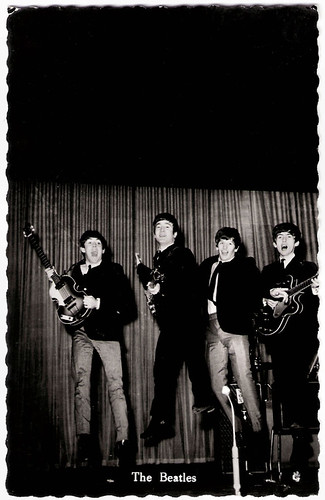
Dutch postcard.
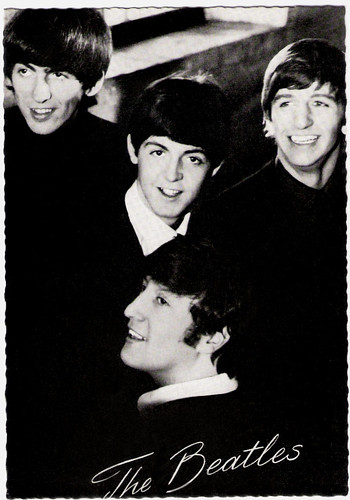
German postcard by Filmbilder-Vertrieb Ernst Freihoff, Essen, no. 984. Retail price: 10 Pfg.
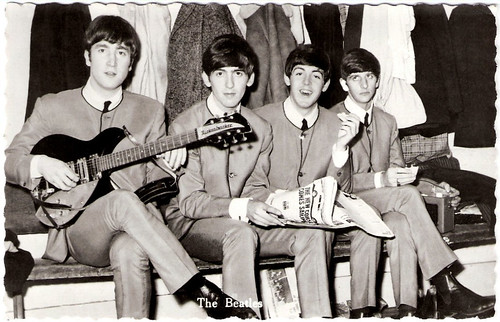
Dutch postcard by Remaco NV, Amsterdam.
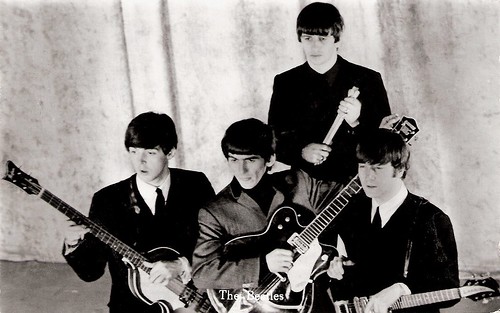
Dutch postcard by Heracles, Haarlem.
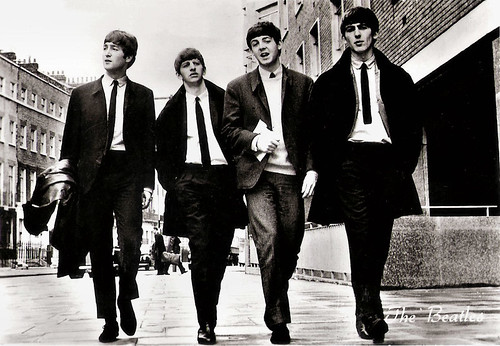
Dutch postcard by Syba, no. 464. Sent by mail in 1964.
Beatlemania
The Beatles achieved mainstream success in the UK at the beginning of 1963. John Lennon married his girlfriend Cynthia Powell when she was pregnant. Lennon had to perform on the evening of his wedding day and would continue to do so almost daily from then on. Brian Epstein, fearing that fans would be alienated by the idea of a married Beatle, asked the Lennons to keep their marriage secret. Julian was born on 8 April 1963. Lennon was on tour at the time and did not see his son until three days later. After the tour, Lennon went on holiday to Spain with Brian Epstein, leading to speculation about their relationship. Questioned about it later, Lennon said, "Well, it was almost a love affair, but not quite. It was never consummated. But it was a pretty intense relationship. It was my first experience with a homosexual that I was conscious was homosexual.” In a later fictional film about this vacation, The Hours and Times (Christopher Munch, 1991), Lennon was played by Ian Hart. In another film about the Hamburg years of the Beatles, Backbeat (Iain Softley, 1994), Hart again played Lennon.
After a year of Beatlemania in the UK, the group's historic February 1964 US debut appearance on The Ed Sullivan Show marked their breakthrough to international stardom. Two years of constant touring, songwriting and filmmaking followed. Richard Lester made two films with The Beatles, A Hard Day’s Night (1964) and Help! (1965). Lennon also wrote two books, 'In His Own Write' and 'A Spaniard in the Works'. The Beatles received recognition from the British Establishment when they were appointed Members of the Order of the British Empire (MBE) in the 1965 Queen's Birthday Honours. Lennon grew concerned that fans attending Beatles concerts were unable to hear the music above the screaming of fans and that the band's musicianship was beginning to suffer as a result. His song Help! (1965) expressed these feelings.
The following January, he was unknowingly introduced to LSD when a dentist, hosting a dinner party attended by Lennon, Harrison and their wives, spiked the guests' coffee with the drug. The Beatles had their final commercial concert on 29 August 1966. Instead of appearing live, the band began making their own ‘pop clips’, which were featured on television programs of the time. Deprived of the routine of live performances, Lennon felt lost and considered leaving the band. Since his involuntary introduction to LSD in January, he had made increasing use of the drug and was almost constantly under its influence for much of the year.
1967 saw the release of 'Strawberry Fields Forever', and the group's landmark album 'Sgt. Pepper's Lonely Hearts Club Band', which revealed Lennon's lyrics contrasting strongly with the simple love songs of the Lennon–McCartney's early years. In August, after having been introduced to the Maharishi Mahesh Yogi, the group attended a weekend of personal instruction at his Transcendental Meditation seminar in Bangor, Wales, and were informed of Epstein's death during the seminar. They later travelled to Maharishi's ashram in India for further guidance, where they composed most of the songs for 'The Beatles' and 'Abbey Road'.
Lennon played in the anti-war, black comedy How I Won the War (Richard Lester, 1967) starring Michael Crawford. McCartney organised the group's first post-Epstein project, the self-written, produced and directed television film Magical Mystery Tour (1967). While the film itself proved to be their first critical flop, its soundtrack release, featuring Lennon's acclaimed, Lewis Carroll-inspired 'I Am the Walrus', was a success. With Epstein gone, the band members became increasingly involved in business activities, and in February 1968, they formed Apple Corps, a multimedia corporation composed of Apple Records and several other subsidiary companies. In the cinema, The Beatles could be heard in the animated film Yellow Submarine (George Dunning, 1968). John and Cynthia divorced after he had fallen in love with Yoko Ono. At the end of 1968, Lennon was featured in the film The Rolling Stones Rock and Roll Circus (not released until 1996) in the role of a Dirty Mac band member. The supergroup, composed of Lennon, Eric Clapton, Keith Richards and Mitch Mitchell, also backed a vocal performance by Yoko Ono in the film.
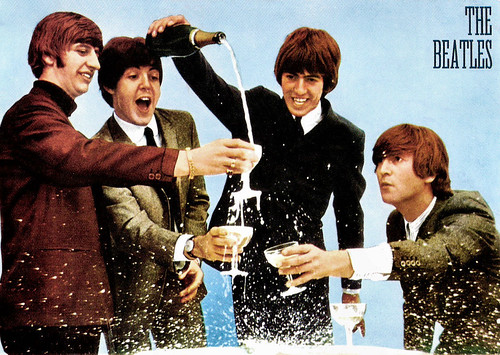
Italian postcard by Silvercart, Milano, no. 514/3. Photo: Nems Enterpriser London Ltd.
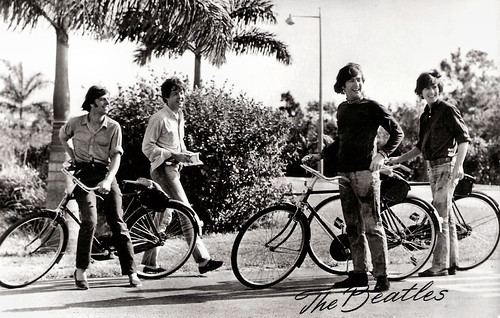
Dutch postcard.
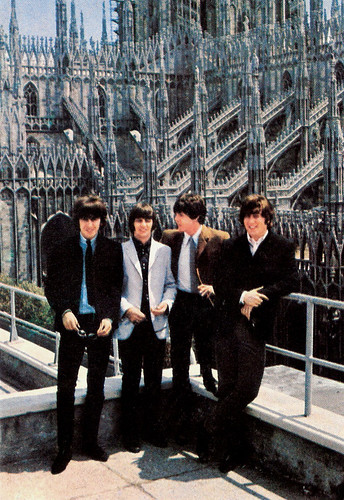
Italian postcard. Photo: Carisch.
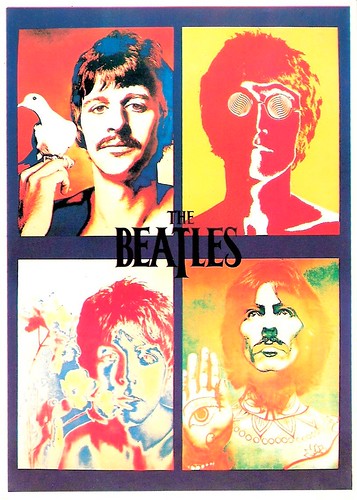
British postcard, no. 1148. Caption: Beatles - psychedelic.
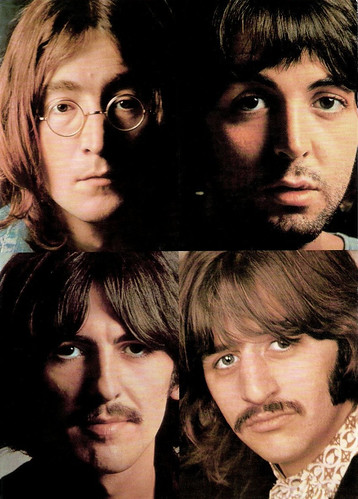
British Postcard by Fotofolio.
Bed-in for peace
John Lennon married Yoko Ono in 1969 and changed his name to John Ono Lennon. The couple spent its honeymoon at the Amsterdam Hilton campaigning with a week-long Bed-In for Peace. At their second Bed-In for Peace in Montreal in 1969, they recorded 'Give Peace a Chance'. It became the main anti-Vietnam protest song. Lennon detailed this period in the Beatles song 'The Ballad of John and Yoko'. They also released a series of 14 lithographs called 'Bag One' depicting scenes from their honeymoon, eight of which were deemed indecent and most of which were banned and confiscated. Lennon's creative focus continued to move beyond the Beatles and between 1968 and 1969 he and Ono recorded three albums of experimental music together: 'Unfinished Music No.1: Two Virgins' (known more for its cover, a nude photograph of Lennon and Ono, than for its music), 'Unfinished Music No.2: Life with the Lions' and 'Wedding Album'. Their live album 'Live Peace In Toronto' became a Top Ten hit.In 1969, they formed the Plastic Ono Band, which featured Ono, guitarist Eric Clapton, bassist Klaus Voormann and drummer Alan White. They released the album 'Live Peace' (1969) and the singles 'Cold Turkey', about his battle with heroin addiction, and 'Instant Karma!' In September 1969, Lennon told the other Beatles that he planned to leave the group and agreed not to inform the media while the group renegotiated their recording contract. He was outraged when McCartney publicised his own departure on releasing his debut solo album in April 1970. Lennon's own debut solo album, 'John Lennon/Plastic Ono Band' (1970), was received with high praise. Stephen Thomas Erlewine at AllMusic: “A scathingly honest confessional work inspired by his and Ono's primal scream therapy. Lennon supported the album with an extensive interview with Rolling Stone, where he debunked many of the myths surrounding the Beatles.” The album featured the songs 'Mother', in which Lennon confronted his feelings of childhood rejection, and the Dylanesque' 'Working Class Hero'.
In protest at Britain's involvement in the Nigerian Civil War, its support of America in the Vietnam war and (jokingly) against the single 'Cold Turkey' slipping down the charts, Lennon returned his MBE medal to the Queen, though this had no effect on his MBE status. In 1971, he moved to Manhattan, where his criticism of the Vietnam War resulted in a lengthy attempt by Richard Nixon's administration to deport him, while some of his songs were adopted as anthems by the anti-war movement and the larger counterculture. Lennon's next album, 'Imagine' (1971), got a more guarded critical response. But the title song became his most famous post-Beatles track, although the lyrics offended religious groups. In December 1971, Lennon and Ono released 'Happy Xmas (War Is Over)'. The new year saw the Nixon administration take what it called a ‘strategic counter-measure’ against Lennon's anti-war and anti-Nixon propaganda, embarking on what would be a four-year attempt to deport him. While Lennon was recording 'Mind Games' (1973), he and Ono decided to separate.
The ensuing 18-month period apart, which he later called his ‘lost weekend’, was spent in Los Angeles and New York in the company of May Pang. Lennon contributed 'I'm the Greatest' to Starr's album 'Ringo' (1973). Lennon then recorded the album 'Walls and Bridges' (1974) with the #1 single 'Whatever Gets You thru the Night', featuring Elton John on backing vocals and piano. Lennon co-wrote 'Fame', David Bowie's first US number one, and provided guitar and backing vocals for the recording. Lennon and Ono were reunited shortly afterwards, and he released 'Rock 'n' Roll' (1975), an album of cover songs. 'Stand by Me', taken from the album and a US and UK hit, became his last single for five years. The same month, Elton John topped the charts with his cover of 'Lucy in the Sky with Diamonds', featuring Lennon on guitar and back-up vocals. Lennon disengaged himself from the music business in 1975 to raise his second son, Sean Lennon, who was born on John's 35th birthday in 1975. John wrote the song 'Beautiful Boy' for Sean. Lennon took on the role of househusband and gave all his attention to his family. He wrote 'Cookin' (In the Kitchen of Love)' for Starr's 'Ringo's Rotogravure' (1976), performing on the track in June in what would be his last recording session until 1980. He appeared in the film Fire in the Water (Peter Whitehead, 1977) with Nathalie Delon.
In 1980, John Lennon and Yoko Ono reemerged with the single '(Just Like) Starting Over' and the album 'Double Fantasy' (1980). Three weeks after the album’s release, on 8 December 1980, John Lennon was murdered. Mark David Chapman shot Lennon in the back four times at the entrance to his New York apartment. Within minutes after being shot, John Lennon was dead at age 40. He was cremated, and Ono scattered his ashes in New York's Central Park, where the Strawberry Fields Memorial was later created. As of 2012, Lennon's solo album sales in the United States exceeded 14 million and, as writer, co-writer or performer, he is responsible for 25 number-one singles on the US Hot 100 chart. The cover of Rolling Stone issue featuring a nude Lennon hugging and kissing a fully clothed Yoko Ono taken by photographer Annie Leibovitz was voted the top magazine cover of the last 40 years by a panel of magazine editors, artists and designers chosen by the American Society of Magazine Editors. The photo was the cover of Rolling Stone's tribute to Lennon after his death. Ironically, the picture was taken on the last day of Lennon's life.

With George Harrison. Spanish postcard by Oscarcolor, no. 347.
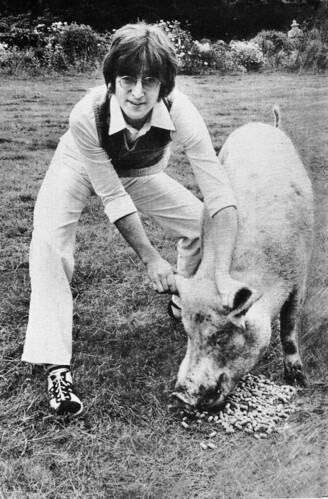
British postcard.

British postcard by Statics, London, no. PC 38. Photo: Sipahloglu.
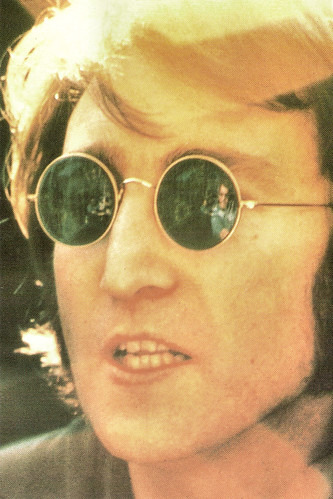
British postcard, no. MM 054. Photo: Immaginazione Stellare, Monaco.

American postcard by Fotofolio, no. P318. Photo: Christopher Makos. Caption: Andy Warhol, 1978. Kissing John Lennon at the Factory.
Sources: Stephen Thomas Erlewine (AllMusic), Wikipedia and IMDb.
This post was last updated on 16 March 2025.
No comments:
Post a Comment